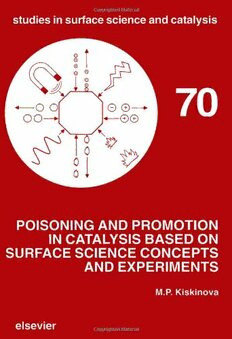Download Poisoning and Promotion in Catalysis based on Surface Science Concepts and Experiments PDF Free - Full Version
Download Poisoning and Promotion in Catalysis based on Surface Science Concepts and Experiments by M. P. Kiskinova in PDF format completely FREE. No registration required, no payment needed. Get instant access to this valuable resource on PDFdrive.to!
About Poisoning and Promotion in Catalysis based on Surface Science Concepts and Experiments
The topics covered in this book include a variety of adsorption and model reaction studies on clean and modified single crystal metal surfaces obtained by means of properly selected surface sensitive techniques. The accent is on the revelation of the physics and chemistry involved in the effects of various modifiers on the adsorptive and reactivity properties of the surface with respect to different reactants. In this book current information that contributes to the fundamental understanding of the effect of additives is summarized. Some of the additives act as promoters, others as poisons, in a number of important catalytic reactions. A description of single- and double-component systems has been obtained by using surface-sensitive techniques, particularly suited for this purpose. For the benefit of the reader, a short summary of the main surface science techniques has been given in Chapter 2. Three general and interrelated topics are reviewed. The first concerns the interaction of electronegative (Cl, S, Se, C, N, O, P) and electropositive (alkali metals) atoms with metal surfaces (Chapter 4). The second topic covers the chemisorptive properties of metal surfaces modified by varying amounts of additives with respect to different reactants (CO, NO, N 2 , O 2 , H 2 , CO 2 , NH 3 , H 2 O and hydrocarbons) (Chapters 5 and 6). In particular the adsorption kinetics and energetics, and the electronic, structural and reactive properties of the coadsorbate systems are considered, whereby particular attention is given to recent surface science studies with well-characterized, single crystal, metal surfaces. In these chapters, special attention is paid to showing the contribution of different factors (the nature and adsorption state of the modifier and the coadsorbed molecule, the structure of the adsorbed layer, the type of interactions in the mixed overlayers, etc.) to the modifier effects. The book will be particularly useful to scientists who are interested in adsorption phenomena, surface properties and catalysis. It should also prove invaluable to those addressing the questions of condensed matter (surfaces and interfaces), materials science (e.g. corrosion of metals) and electrochemistry.
Detailed Information
| Author: | M. P. Kiskinova |
|---|---|
| Publication Year: | 1991 |
| ISBN: | 9780080887401 |
| Pages: | 359 |
| Language: | English |
| File Size: | 6.295 |
| Format: | |
| Price: | FREE |
Safe & Secure Download - No registration required
Why Choose PDFdrive for Your Free Poisoning and Promotion in Catalysis based on Surface Science Concepts and Experiments Download?
- 100% Free: No hidden fees or subscriptions required for one book every day.
- No Registration: Immediate access is available without creating accounts for one book every day.
- Safe and Secure: Clean downloads without malware or viruses
- Multiple Formats: PDF, MOBI, Mpub,... optimized for all devices
- Educational Resource: Supporting knowledge sharing and learning
Frequently Asked Questions
Is it really free to download Poisoning and Promotion in Catalysis based on Surface Science Concepts and Experiments PDF?
Yes, on https://PDFdrive.to you can download Poisoning and Promotion in Catalysis based on Surface Science Concepts and Experiments by M. P. Kiskinova completely free. We don't require any payment, subscription, or registration to access this PDF file. For 3 books every day.
How can I read Poisoning and Promotion in Catalysis based on Surface Science Concepts and Experiments on my mobile device?
After downloading Poisoning and Promotion in Catalysis based on Surface Science Concepts and Experiments PDF, you can open it with any PDF reader app on your phone or tablet. We recommend using Adobe Acrobat Reader, Apple Books, or Google Play Books for the best reading experience.
Is this the full version of Poisoning and Promotion in Catalysis based on Surface Science Concepts and Experiments?
Yes, this is the complete PDF version of Poisoning and Promotion in Catalysis based on Surface Science Concepts and Experiments by M. P. Kiskinova. You will be able to read the entire content as in the printed version without missing any pages.
Is it legal to download Poisoning and Promotion in Catalysis based on Surface Science Concepts and Experiments PDF for free?
https://PDFdrive.to provides links to free educational resources available online. We do not store any files on our servers. Please be aware of copyright laws in your country before downloading.
The materials shared are intended for research, educational, and personal use in accordance with fair use principles.

